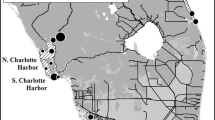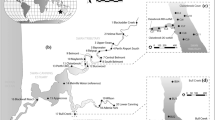Abstract
The lower Passaic River in northern New Jersey (USA) has been heavily industrialized since the mid-nineteenth century and its shoreline and aquatic habitats degraded or destroyed. Similar to other urban systems, Passaic River sediments, both surface and buried, historically have contained elevated levels of numerous contaminants that may pose risks to ecological receptors and humans. Sediments from 15 stations in the lower Passaic River and 3 reference stations in the Mullica River in southern New Jersey were sampled in 1999 and characterized for chemical contamination, toxicity, and impairment of the benthic community. The objective of this study was to determine the incidence, degree, and nature of degraded surficial sediments in the area to support subsequent plans for restoration of the system. Results demonstrated that Passaic River sediments had concentrations of many organic and inorganic contaminants at levels significantly greater than the reference area and effect-based guidelines. Sediments were toxic to marine amphipods at 11 stations and the benthic assemblages were impaired relative to the reference area at all stations. The weight-of-evidence of this sediment quality triad (SQT) assessment indicates that impacts from multiple contaminants are occurring throughout the lower Passaic River and, that these impacts must be evaluated further and addressed as part of ongoing restoration initiatives for the river.
Similar content being viewed by others
References
Anderson, B. S., Hunt, J. W., Phillips, B. M., Fairey, R., Roberts, C. A., Oakden, J. M., et al. (2001). Sediment quality in Los Angeles Harbor, USA: A triad assessment. Environmental Toxicology and Chemistry, 20(2), 359–370.
Armstrong, T. N., Iannuzzi, T. J., Thelen, J. B., Ludwig, D. F., & Firstenberg, C. E. (2005). Characterization of chemical contamination in shallow-water estuarine habitats of an industrialized river. Part II: Metals. Soil and Sediment Contamination, 14, 33–50.
ASTM. (1992). Standard guide for conducting 10-day static sediment toxicity tests with marine and estuarine amphipods (pp. 268–293). Philadelphia, PA: American Society for Testing and Materials.
Boothman, W. S., Hansen, D. J., Berry, W. J., Robson, D. L., Helmstetter, A., Corbin, J. M., et al. (2001). Biological response to variation of acid-volatile sulfides and metals in field-exposed spiked sediments. Environmental Toxicology and Chemistry, 20(2), 264–272.
Bridges, T. S., & Farrar, J. D. (1997). The influence of worm age, duration of exposure and endpoint selection on bioassay sensitivity for Neanthes arenaceodentata (Annelida: Polychaeta). Environmental Toxicology and Chemistry, 16, 1650–1658.
Canfield, T. J., Dwyer, F. J., Fairchild, J. F., Haverland, P. S., Ingersoll, C. G., Kemble, N. E., et al. (1996). Assessing contamination in Great Lakes sediments using benthic invertebrate communities and the Sediment Quality Triad approach. Journal of Great Lakes Research, 22(3), 565–583.
Chapman, P. M. (1992). Sediment quality triad approach. Sediment classification methods compendium. EPA/823-R-92-006. Washington, DC: US Environment Protection Agency.
Chapman, P. M. (1996). Presentation and interpretation of Sediment Quality Triad data. Ecotoxicology, 5, 327–339.
Chapman, P. M., Anderson, B. S., Carr, R. S., Engle, V., Green, R., Hameedi, J., et al. (1997). General guidelines for using the Sediment Quality Triad. Marine Pollution Bulletin, 368–372.
Diaz, R. J., & Rosenberg, R. (1995). Marine benthic hypoxia – review of ecological effects and behavioral responses on macrofauna. Oceanograpyh and Marine Biology, Annual Review, 33, 245–303.
Hansen, D. J., Berry, W. J., Mahony, J. D., Boothman, W. S., Di Toro, D. M., Robson, D. L., et al. (1996). Predicting the toxicity of metal-contaminated field sediments using interstitial concentrations of metals and acid-volatile sulfide normalizations. Environmental Toxicology and Chemistry, 15(12), 2080–2094.
Iannuzzi, T. J., Armstrong, T. N., Thelen, J. B., Ludwig, D. F., & Firstenberg, C. E. (2004). Chemical contamination of aquatic organisms from an urbanized estuarine river. Human and Ecological Risk Assessment, 10(2), 389–413.
Iannuzzi, T. J., Armstrong, T. N., Thelen, J. B., Ludwig, D. F., & Firstenberg, C. E. (2005). Characterization of chemical contamination in shallow-water estuarine habitats of an industrialized river. Part I: Organic compounds. Soil and Sediment Contamination, 14, 13–33.
Iannuzzi, T. J., Ludwig, D. F., Kinnell, J. C., Wallin, J. M., Desvousges, W. H., & Dunford, R. W. (2002). A common tragedy: History of an urban waterway. Amherst, MA: Amherst Scientific Publishers.
Johnson, D. E. (1998). Applied multivariate methods for data analysts. Pacific Grove, CA: Duxbury Press.
Long, E. R., Field, L. J., & MacDonald, D. D. (1998). Predicting toxicity in marine sediments with numerical sediment quality guidelines. Environmental Toxicology and Chemistry, 17(4), 714–727.
Long, E. R., Hameedi, M. J., Sloane, G. M., & Read, L. B. (2002). Chemical contamination, toxicity, and benthic community indices in sediments of the lower Miami River and adjoining portions of Biscayne Bay. Estuaries, 25(4A), 622–637.
Long, E. R., Ingersoll, C. G., & MacDonald, D. D. (2006). Calculation and uses of mean sediment quality guideline quotients: A critical review. Environmental Science and Technology, 40(6), 1726–1736.
Long, E. R., & MacDonald, D. D. (1998). Recommended uses of empirically derived, sediment quality guidelines for marine and estuarine ecosystems. Human and Ecological Risk Assessment, 4(5), 1019–1039.
Long, E. R., MacDonald, D. D., Severn, C. G., & Hong, C. B. (2000). Classifying probabilities of acute toxicity in marine sediments with empirically derived sediment quality guidelines. Environmental Toxicology and Chemistry, 19(10), 2598–2601.
Long, E. R., MacDonald, D. D., Smith, S. L., & Calder, F. D. (1995a). Incidence of adverse biological effects within ranges of chemical concentrations in marine and estuarine sediments. Environment and Management, 19(1), 81–97.
Long, E. R., Robertson, A., Wolfe, D. A., Hameedi, J., & Sloane, G. M. (1996). Estimates of the spatial extent of sediment toxicity in major U. S. estuaries. Environmental Science & Technology, 30(12).
Long, E. R., & Sloane, G. M. (2005). Development and use of assessment techniques for coastal sediments (pp 63–78). In: S. A. Bortone (Eds.), Estuarine Indicators. Boca Raton, FL: CRC Press.
Long, E. R., Wolfe, A., Scott, K. J., Thursby, G. B., Stern, E., Peven, E., et al. (1995b). Magnitude and extent of sediment toxicity in the Hudson–Raritan estuary. NOAA Tech Memo. NOS ORCA 88 (230 p). Silver Spring, MD: National Oceanic and Atmospheric Administration.
Ludwig, D. F., & Iannuzzi, T. J. (2005). Incremental ecological exposure risks from contaminated sediments in an urban estuarine river. Integrated Environmenatl Assessment and Management, 1(4), 374–390.
Phillips, B. M., Hunt, J. W., Anderson, B. S., Puckett, H. M., Fairey, R., Wilson, C. J., et al. (2001). Statistical significance of sediment toxicity test results: Threshold values derived by the detectable significance approach. Environmental Toxicology and Chemistry, 20(2), 371–373.
Thursby, G. B., Heltshe, J., & Scott, K. J. (1997). Revised approach to toxicity test acceptability criteria using a statistical performance assessment. Environmental Toxicology and Chemistry, 16(6), 1322–1329.
USEPA. (1998). Sediment quality of the NY/NJ Harbor System: An investigation under the Regional Environmental Monitoring and Assessment Program (REMAP). EPA/902-R-98-001. Washington, DC: US Environmental Protection Agency.
USEPA. (2000). Estuarine and coastal marine waters: bioassessment and biocriteria technical guidance. Office of Water. EPA-822-B-00-024. Washington, DC: US Environmental Protection Agency.
USEPA. (2003). Final Report. Sediment quality of the NY/NJ Harbor System: a 5-year revisit 1993/4–1998. An investigation under the Regional Environmental Monitoring and Assessment Program (REMAP). EPA/902-R-03-002. Washington, DC: US Environmental Protection Agency.
USEPA. (2004). National Coastal Condition Report II. Office of Research and Development. EPA-620/R-03/002. US Environmental Protection Agency.
USEPA. (2005). Procedures for the derivation of equilibrium partitioning sediment benchmarks (ESBs) for the protection of benthic organisms: metal mixtures (cadmium, copper, lead, nickel, silver and zinc). EPA/600/R-0211. Washington, DC: US Environmental Protection Agency.
Van den Berg, M., Birnbaum, L., Bosveld, A. T. C., Brunstrom, B., Cook, P., Feeley, M., et al. (1998). Toxic equivalency factors (TEFs) for PCBs, PCDDs, PCDFs for humans and wildlife. Environmental Health Perspectives, 106(12), 775–789.
Wallin, J. M., Ludwig, D. F., Hattersley, M. D., & Iannuzzi, T. J. (2002). Historical assessment of the impacts of chemicals in sediments on benthic invertebrates in the tidal Passaic River, New Jersey. Human and Ecological Risk Assessment, 8(5), 1155–1176.
Weisberg, S. B., Ranasinghe, J. A., O’Connor, J. S., & Adams, D. A. (1998). A Benthic Index of Biotic Integrity (B-IBI) for the New York/New Jersey Harbor. Appendix C in Sediment quality of the NY/NJ Harbor System: An investigation under the Regional Environmental Monitoring and Assessment Program (REMAP). EPA/902-R-98-001. Washington, DC: US Environmental Protection Agency.
Wenning, R. J., Bailey, G. E., Ingersoll, C. G., & Moore, D. W. (2005). Use of sediment quality guidelines and related too for the assessment of contaminated sediments. Pensacola, FL: Society of Environmental Toxicology and Chemistry.
Author information
Authors and Affiliations
Corresponding author
Rights and permissions
About this article
Cite this article
Iannuzzi, T.J., Armstrong, T.N., Long, E.R. et al. Sediment quality triad assessment of an industrialized estuary of the northeastern USA. Environ Monit Assess 139, 257–275 (2008). https://doi.org/10.1007/s10661-007-9832-x
Received:
Accepted:
Published:
Issue Date:
DOI: https://doi.org/10.1007/s10661-007-9832-x




